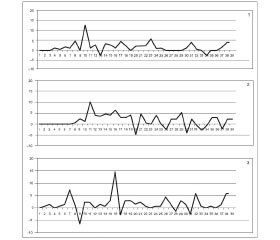Международный неврологический журнал 5 (75) 2015
Вернуться к номеру
Saccadic eye movement in structure neuroleptic extrapyramidal disorders, view of neurologist
Авторы: А.Shebatin - KU "Regional Clinical Psychiatric Hospital" Zaporizhzhya Regional Council. Ukraine
Рубрики: Неврология
Разделы: Справочник специалиста
Версия для печати
The most important place among drug parkinsonism takes parkinsonism caused by antipsychotics - neuroleptic parkinsonism. The clinical picture it is very variable, and sometimes the objective symptoms are not as pronounced. Making it difficult to control the side effects of the drug, making signs to look for additional diagnostics. To those attributes may include, early enough arise when extrapyramidal disease, oculomotor disturbances. The aim is to describe visually observed saccadic glazodvizheniya with extrapyramidal disorders caused by taking neuroleptics as well as a comparative analysis of saccades occurring in patients with neurological disorders and in patients not having such pathology.
Materials and methods. Material; these studies 298 patients, patient selection was carried out in accordance with the recommendations of the DSM IV. Group 1, with no neurological disorders, 142 patients age 34.97 ± 0,698 years. Group 2 140 patients with neurological disorders. age 50,02 ± 1,284 years. Group 3, the control, 10 patients undergoing, neuroleptic therapy, with no signs of neuroleptic extrapyramidal symptoms. age 32,7 ± 3,141 per year. 4th group of patients with Parkinson's syndrome is not neurotic etiology, 6 persons average age 32,7 ± 3,141 per year. Methodology: when checking glazodvizheniya neurological hammer at the patient's eye was located at a distance of 35 centimeters, horizontal motion with an amplitude of 40 cm., A frequency of 40 movements in 1 minute. 10-12 was performed movements of the eyeball moving speed corresponded - 45 ° / sec.
Results and discussion. Extrapyramidal disorder arose after admission: in group 1 in the last 7 days 54.9%, up to 10 days 60.56%, up to 14 days 63.3%. In group 2 to 7 days 64.29%, up to 10 days 74.29%, up to 14 days 77.9%. In the first 7 days no statistical difference. Over a period of 10 days, and especially at the end of the second week of receiving neuroleptics, the statistical difference between groups 1 and 2 are significant at p ≤ 0,01. In group 3, the visual movement of the eyeballs was smooth, storyboard glazodvizheniya ris.№1, smooth glazodvizheniya diagram Figure 2. Smooth movement, begins with a latency of 120 ms., And flows with an average amplitude of 1,78 ± 0,58 ug.gr. Saccadic glazodvizhenie presented at ris.№3 and №4, says that it has a latency of 40 ms beginning 320 ms during movement latencies of 40 ms to 160 ms, and a saccade in the opposite direction in 4 groups determined by the total volume saccadic eye movements. In patients receiving antipsychotics in 2 patients had "transient paresis gaze" disappears after rest. After cessation of treatment, this phenomenon disappeared. In groups 1 and 2 were observed at all saccadic glazodvizheniya. Options features saccadic glazodvizheniya in groups 1 and 2. 1. appears immediately after the start of movement of the eyeballs and in group 1 was 92 case (66.7%) in group 2 92sluchaev (66.7%), no statistical difference was not observed. 2. There was not immediately after the beginning of the movement, and after a short time, the first 2-3 movement, smooth movement of the eyes, which goes into a saccade. In group 1, 30 cases (21.7%) in Group 2 18 2 cases (13%). 3. The kind of movement is the same as observed in group 4, when there was a sense of "transient paresis gaze", which after a short rest (2-3sek) movement resumed in full. 1 group of 12 cases (8.7%), 26 cases of group 2 (18.8%), the statistical difference between the groups at p≤0,05. 4. glazodvizhenie smooth, two, three becomes a saccade. is stopped and there is a "transient paresis of sight." In group 1 4 cases (2.9%) in group 2, this phenomenon has been observed in 2 cases (1.4%), no statistical difference. Cases with "transient paresis sight" in group 1 of 16 cases (11.6%), while in group 2, 28 cases (20.2%), the difference is statistically p≤0,05, all cases were accompanied by severe extrapyramidal symptoms
Conclusions. Neyrolepticheskie extrapyramidal disorder accompanied by visually determines glazodvizheniem saccade, which is one of the early signs. The emergence of "transient paresis gaze indicates the progression of neuroleptic complications. Neuroleptic extrapyramidal disorder after the first week of supplementation, are more common in patients with neurological disorders, to the frequency of occurrence of this disorder does not depend on the presence or absence of neurological disease. Extrapyramidal disorders correlates with changes in saccadic glazodvizheniya, the appearance of "transient paresis of the eye."

